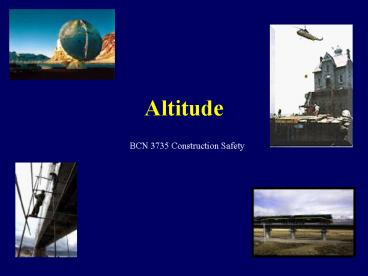Altitude - PowerPoint PPT Presentation
1 / 15
Title: Altitude
1
Altitude
- BCN 3735 Construction Safety
2
Agenda
- Introduction
- Construction at high Altitudes
- Effects of high altitude
- Precautions
- Conclusion
3
Introduction
- 40 Million people live at altitudes over 3000 m
- Impossible to live at altitudes over 5500 m for
more than a few months. - Improvements in technology are allowing for new
construction in more difficult and dangerous
areas. - Safety concerns include tight working spaces
,maintenance of mechanical equipment and worker
safety. - Medical concerns are very serious and attended to
with every precaution.
4
Construction at High Altitudes
- China Tibet Train
- Qinghai to Tibet
- 30 kilometers of tunnels and 286 bridges
- Line lies between 4000 and 5000 meters
- Asphalt Paving in the Rocky Mountains
- Trail Ridge Road in Rocky Mountain National Park,
12,183 feet - Pikes Peak Toll Road
- Telescopes
- Mauna Kea, Hawaii (altitude 4200 m)
- Chajnantor plateau in north Chile at an altitude
of 5050 m.
5
Why does high altitude affect us?
- All the medical effects of high altitude are
caused by oxygen deprivation. - The reduction in oxygen is best described by the
fall in inspired partial pressure of oxygen - These altitudes can have serious physical effects
on humans. - The three major areas that are affected are
- mental performance
- physical performance
- quality of sleep
6
High Altitude Diseases
- Altitude Sickness- Hypoxia
- Low oxygen pressure
- Ambient pressure and partial pressure of oxygen
decrease with altitude. - AMS- Acute Mountain Sickness
- Monges Disease
- Rarely occurs below 2500 m
- Headache, drowsiness, general fatigue, difficulty
breathing during physical exertion, nausea, loss
of appetite.
7
High Altitude Diseases
- High Altitude Pulmonary Edema- HAPE
- May when ascending rapidly from sea level to
altitudes over 2500 m. - Symptoms such as coughing, fatigue and breathing
difficulties usually appear 2 to 7 days after
arrival. - High blood pressure in the lungs forces fluid
into the lung tissue, possibly impeding oxygen
from moving through the alveoli to the blood. - Woman are at less risk teenagers and children at
higher risk.
8
High Altitude Diseases
- High Altitude Cerebral Edema- HACE
- serious, but rare condition where fluid leaks
out of capillaries into the brain tissue. - Begins like acute mountain sickness but
progresses to loss of balance, difficulties with
walking, clouding of consciousness, irrational
behavior and coma.
9
Effects of High Altitude
- Mental Performance
- arithmetical errors
- reduced attention span
- increased fatigue
- impaired short-term memory
- increased difficulty in making decisions.
- Conditions improved after acclimatization.
10
Effects of High Altitude
- Physical Performance
- physical work performance (power output) depends
on the - amount of oxygen available to the body.
- As altitude increases, maximal oxygen uptake
falls. - At 4200 m, power output of the body is reduced to
about 70 of its sea level value. - Muscular exertion
- Fatigue and Panting
- Difficult to recover from full days work
11
Effects of High Altitude
- Quality of Sleep
- Difficulties sleeping noticeable at 2500 to 3000
m (like at ski resorts) - wake frequently, have unpleasant dreams, and do
not feel - refreshed in the morning
- Caused by periodic breathing, waxes and wanes of
breath with typical cycles of ten to fifteen
seconds - Apnea, no breathing at all, may occur for five to
ten seconds.
12
Precautions and Prevention
- Acclimatization- adapting to the oxygen
deprivation of high altitude to some extent - Hyperventilation
- Polycythemia
- Increased concentration of capillaries in some
body tissues - changes of oxidative enzymes in the cells
- full acclimatization requires continuous
residence at - the altitude for about ten days.
13
Precautions and Prevention
- Acclimatization- adapting to the oxygen
deprivation of high altitude to some extent - Although acclimatization ameliorates the hypoxia
of high altitude to some extent, professionals
still recommend supplementary oxygen.
14
Precautions and Prevention
- Plenty of rest
- Avoid alcohol
- Avoid tobacco
- Avoid marijuana
- Stay hydrated
- Avoid heavy meals
15
Conclusion
- Today there are many reasons for working at high
altitudes, but these altitudes can seriously
impair human mental and physical performance and
quality of sleep. - Acclimatization is crucial to high altitude work,
but it not always sufficient. - The introduction of supplemental oxygen , or
concentrated oxygen where workers sleep,
dramatically improves conditions.

